Knowledge Mapping for Collaboration
between Schools and Cultural Heritage Institutions
///////
This page is a sub-page of our page on NSDL (Nya Samarbetsformer i det Digitala Lärandelandskapet.
///////
Related KMR-pages:
• Modeling and Mapping
• Knowledge Gap Mapping
• CHARGE (Cultural Heritage Asynchronous Research Grid Environment)
• Asynchronous Public Service
• MATCH (MAthematical Transformations for Cultural Heritage)
• Modeling and Mapping
• Knowledge Negotiations
• Knowledge Manifolds
• Disagreement Management
• Collectigence
///////
Overview of purpose
To help schools and cultural institutions to interact better with regard to different knowledge-building processes that can strengthen the interaction between formal and informal learning.
Summary
Cultural heritage institutions can support schools in their personalization of learning processes (in accordance with the curriculum) by making use of knowledge mapping as a strategic tool to enhance the students’ engagement and interest in their own learning processes.
Students will be able to get help from knowledge mappers to create their own knowledge maps. Such a map consists of
(1) a knowledge-gap map that describes where the student is and where s/he would like to be in the knowledge landscape,
(2) a knowledge development plan (knowledge roadmap) which contains descriptions of various possible knowledge trails (paths) to get there, and
(3) reflections on learning experiences from the executed knowledge hikes along these trails.
Keywords
knowledge mapping, knowledge map, knowledge gap, knowledge trail, knowledge hike, knowledge network, opportunity network, personalized learning.
Purpose and background of the project
Societal benefit has always been a central aim of research at KTH which is (and has been) collaborating closely with the major industrial companies in Sweden and also with the rest of society in areas such as urban planning, construction and transport. The ECE school is building a strong research environment in learning and technology education research from different perspectives. The school is responsible for two teacher training programmes in technology, one at the elementary and one at the high school level.
In 2012 the dean of the ECE school approached the major cultural heritage institutions as well as Digisam in order to explore if it was possible to develop a similar long term research and development collaboration with them as the ones that KTH already has with e.g., Scania and Ericsson. KTH wants to contribute to society by researching and developing methods and tools to support the complex and evolving information management process that the cultural heritage sector needs to develop in order to deliver on its mission of storing and making available cultural heritage material and information in digital form.
The willingness to cooperate has been documented in a letter of intent between KTH and a number of agency directors in October 2012 to go ahead and shape a project called “Innovative uses of digitized material for education.” Here is a translated citation from this document
“The project is a joint development where representatives of schools, cultural heritage institutions, Digisam and KTH researchers collaborate. The goal is to create value for primary and secondary schools, colleges and universities as well as for the surrounding society. Another aim is to create a platform and build networks for long-term collaboration between KTH, cultural heritage institutions and Digisam.”
In this spirit we have conducted joint seminars and received funding for two development projects and are now facing several new joint research applications in the field of cultural heritage and learning. Through the activities within NSDL-1, the collaboration has also extended to include the University of Borås and the Swedish School of Library and Information Science (SSLIS).
Although it is outside the focus area for NSDL-2, it is worth mentioning that SSLIS and KTH have started discussions on developing a training program in knowledge mapping within the library education program for which SSLIS is responsible. This plan is part of the research program CHARGE (Cultural Heritage Asynchronous Research Grid Environment) which has been formulated in cooperation between KTH and SSLIS, and which is described in the interim report from NSDL-1.
Relevance to the cultural environment, cultural heritage and cultural work
A key point of the NSDL project is that the information architecture of the project is constructed in accordance with the emerging infrastructure for digital management of cultural and heritage information coordinated by Digisam. The infrastructure modeling work carried out within the NSDL-1 project has reinforced this strategic connection.
Today, the classical information processing methods within the heritage domain are being increasingly challenged by modern knowledge management methods. This challenge is about creating good conditions for the emergence of bottom-up created federated knowledge – through knowledge networks that can grow and expand dynamically and where the quality of the contributions can be determined retrospectively by the visibility of the “user-praise” for knowledge contributions that proved useful and stimulating experiences for anyone within any particular context.
From a given knowledge position you can consider activities in the surrounding knowledge network from three different perspectives: intra, inter and supra. If you look down/inward you are assuming an intra-perspective, if you look horizontally/between you are assuming an inter-perspective, and if you look up/out you are assuming a supra-perspective. In the so-called triple-C model (Hofkirchner, 2013) the intra-perspective corresponds to cognition, the inter-perspective to communication and the supra-perspective to collaboration.
A supra-structure, then, is a number of agents who act together on a new level (= one level up/out). Seen from this level, these agents form the parts of the intra-structure defined by their activities as an organism or organization.
Using the terminology of the triple-C model, the overall problem of infrastructural knowledge development can be formulated as follows: How can we represent and orchestrate the interplay between the intra- and inter-structures of knowledge so that we maximize the potential for the occurrence of unplanned and positively synergistic knowledge supra-structures, i.e., opportunistic and advantageous collaborative activities?
Theory
The present project is located within the intersection between strategic web science, inquiry-based learning and visual analytics (Abadala et al., 2010; Börner, 2013). Research in strategic web science has shown the importance of personal and sophisticated information which can be made available for both professionals and amateurs in order to enable quality navigation that can support important decision processes as well as every day practices. However, these insights need to be combined with a personalized approach to education (Naeve, 2010; Nolin, 2013) in order to ensure that the most relevant information resources are able to reach the corresponding individuals in opportune situations and within the appropriate context. The required matching of strategic content to individual goals and requests is a challenge which is focused in this project. The problem we deal with is the following:
How can state-of-the-art interactive visual and semantic technologies support and enhance inquiry-based learning through the use of the most relevant meta-content for the individual, the situation and the context?
The current project is trying to expand the support for inquiry-based learning through visual tools. The basic idea is to design techniques and methods for strategic knowledge mapping as a tool for individuals and organizations to support their own knowledge building processes (Naeve, 2013).
A central concept in this context is the concept of knowledge domain (Hjørland and Albrechtsen, 1995, Hjørland, 2002). Compared to subjects, knowledge domains are broader and more inclusive from a social perspective which includes the needs of society. Knowledge domains can be viewed as aggregated information from a variety of knowledge sources – sources that can be linked together to form networks in the form of knowledge manifolds (Naeve, 2001a). Our goal is to investigate the use of meta-learning tools in order to better construct and navigate such knowledge manifolds.
Method
The project will apply a mixed methodology from design science research (Peffers et al., 2013) and practice research (Goldkuhl, 2011). Here one studies a local practice but formulates research questions in such a way that the results can be applied to a more general practice.
Through knowledge mapping, we will create a mix between the cata-logical (top-down) teaching perspective and the ana-logical (bottom-up) student perspective. The fundamental research question is about how to represent and describe these opposing perspectives in ways that optimize the potential for positively synergistic mixtures between them.
The more general practice within which our results can be expected to be applicable has to do with how to represent and orchestrate the interplay between the intra-, inter-, and supra-structural levels of knowledge in order to maximize the potential for the occurrence of “unexpected” supra-structures, i.e., unplanned and opportunistic collaborations.
Our method for evaluating the learning potential of the proposed activities will be based on the following: The various participants in the knowledge mapping process will be observed by a “think-aloud” study (think-aloud study) while they are engaged in the process of knowledge mapping. This involves an evaluation of both the method and the tools of the process. The participating students will also respond to a pre-survey and a post-questionnaire regarding their attitudes towards the subject, in order to find out how these attitudes are influenced by the experience of knowledge mapping and the subsequent learning activities.
National and international overview of earlier research
The current project is trying to expand the support for query-based learning through visual tools. The basic idea is to develop techniques and tools for strategic knowledge mapping as a method for individuals and organizations to improve their own knowledge building processes.
Today, “supportive interventions” for inquiry-based learning are mostly geared toward conventional communication such as the analog or digital text-based document. The use of visual tools for strategic communications has remained much less explored. However, within the fields of information fusion and visual analysis, some attempts have been made to support decision making by visualizing the results of the algorithmic processing of large data sets.
Another fruitful way to use visual tools for strategic communication is the (media) rich interactive narratives developed by Kathy Boerner (2013) which give users access to free exploration of a variety of visual and textual tools within the same user interface.
Implementation plan, time plan, activities and project roles
During NSDL-1 two suitably controversial themes have emerged:
1) “Riots and conflicts’: What similarities and differences exist between such conflicts as Husby 2013, Gothenburg 2001, and Ådalen 1931?
2) Become “Climate-Energy-and-Environment Smarter” through a better understanding of the underlying scientific models.
These themes will be linked to two different groups, which we may call the Eastern Svealand Group (theme 1) and the Western Gotaland Group (theme 2).
The project consists of two phases:
Phase 1 (Jan-Feb): Planning and resource allocation.
During this phase, the reference group will work to:
• locate interested and suitable teachers
• locate suitable knowledge mappers
• decide how many students we have the possibility to work with
• examine the support activities needed to make it work
• allocate the corresponding resources (financial and in kind)
Phase 2 (March-December): Execution and parallel evaluation of the knowledge mapping activities. We expect to implement knowledge mapping activities with at least one class of pupils within each theme.
Project roles:
Modeling facilitator:
Didactical expert:
Evaluation facilitator:
Digitization coordinator:
Metadata expert:
IT-support:
Expected results and impact
Knowledge mapping could be a useful tool in a variety of contexts outside of schools – for both individuals and organizations. Knowledge mapping has the makings of a popular movement.
The effects of the NSDL project are reinforced by the fact that it is part of a joint research and development program that we call CHARGE (Cultural Heritage Asynchronous Research Grid Environment), that has been developed in collaboration between KTH, Digisam, and SSLIS.
• CHARGE is a research program that aims to bring together and align strategic initiatives with research institutes and cultural heritage institutions. One premise is that cultural heritage institutions need to evolve and develop as a result of the so-called “triple revolution” that has appeared in the digital age: the internet revolution, the social revolution and the mobile revolution.
• CHARGE deals with the transformation of the landscape of public institutions with a focus on synchronous versus asynchronous interactions. Traditional public service institutions favor synchronous modes of one-way delivery while Internet-based cultural interaction permits the development of intelligent blends between asynchronous and interactive (synchronous) activities. This fact has not been discussed in previous research on public institutions.
• CHARGE aims to attend to the troubling situation that public service institutions have been slow in catching on to the need for citizens to produce, archive and distribute content. Instead, social media platforms such as Facebook, YouTube and Instagram have exploited this need. Since, on the face of it, these appear to be freely available services, social media platforms have in many ways functioned as traditional public service institutions. Nevertheless, customers have been paying through the delivery of personal data which then can be translated into various forms of commercial currencies.
• CHARGE is committed to rethinking and repositioning cultural heritage institutions as public service institutions of the digital age. CHARGE aims to develop insights, tools, strategies and practices that facilitate both convergence within public service institutions and highly attractive asynchronous services for citizen-based content production, dissemination, archiving and consumption.
Co-financing
Currently there are no co-financiers. However, several members of the Liaison Group (including Digisam) have declared that they will contribute time “in kind”
We also intend to seek funding from several other sources for developing and researching various aspects of the knowledge mapping process. Natural financing candidates to target are Bank of Sweden Tercentenary Foundation (Feb. 2014) and the Swedish Research Council (March 2014). The ECE school at KTH has also entered into a strategic partnership with SSLIS in Borås on the development of a new type of library education for knowledge mapping.
///////
///////
NSDL – next phase – peaking into knowledge-gap-mapping:
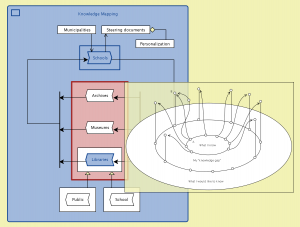
///////
NSDL – next phase – conflicts – spacification – climate smarter:
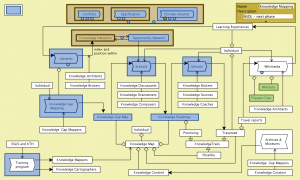
///////
NSDL – next phase – peaking into opportunity networks:
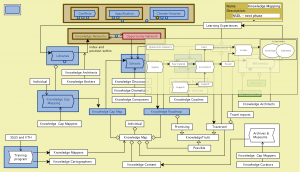
///////
NSDL – next phase – peaking into Influence platform for Horizon 2020:
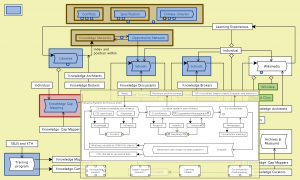
///////
Influence platform (VINNOVA proposal 2013) 1:
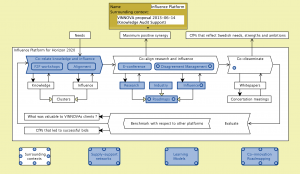
///////
Influence platform for Horizon 2020 (VINNOVA proposal 2013) 2:
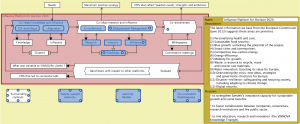
///////
Influence map for Horizon 2020 (Austerity example):
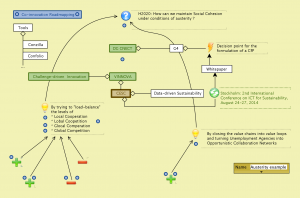
///////
KTH – strategy map for Horizon 2020:
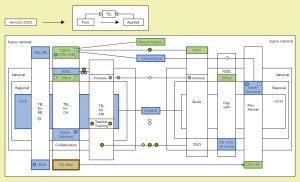
///////
List of the most important publications within the field:
• Abadala, N., Datha, N, Joy, J, Kulkarni, C., Manchepalli, A, Sankar, A., Walton, R., (2010) An Interactive Multimedia Framework for Digital Heritage Narratives, ACM, 978-1-60558-6/10/10.
• Börner, K., (2013) Mapping Science, Cyberinfrastructure for Network Science Center, Indiana University, Bloomington, IN,
• Ebner, H., Palmér, M., Naeve, A., (2007) Collaborative Construction of Artefacts, Proc. of the 4th Conf. on Professional Knowledge Management – Experiences and Visions, Potzdam, Germany, March, 2007.
• Enoksson, F., (2011) Flexible Authoring of Metadata for Learning – Assembling Form from a Declarative Data and View Mode, Licentiate Thesis at the CSC-school, KTH, Trita-CSC-A, ISSN 1653-5723, 2011.
• Goldkühl, G., (2011), The research practice of practice research: theorizing and situational inquiry, Systems, Signs & Actions: Intl. Journal on Communication, Information Technology and Work, Vol. 5 (2011), No. 1, pp. 7–29,
• Gorelick, C., Milton, N., April, K. (2004) Performance Through Learning – Knowledge Management in Practice, Elsevier Inc., 2004, ISBN 0-7506-7582-9.
• Kamtsiou, V., Olivier, B., Derntl, M., Millwood, R., Naeve, A., (2013) Dynamic Roadmapping: Managing Innovation in Turbulent Times, Deliverable D2.6 from the TEL-Map FP7 support action for future gazing within the field of TEL.
• Maier, R., (2005) Modeling Knowledge Work for the Design of Knowledge Infrastructures, Journal of Universal Computer Science, vol. 11, no. 4 (2005), pp 429-451.
• Naeve, A., (2001a), The Knowledge Manifold – an educational architecture that Supports Inquiry-Based Customizable Forms of E-learning, Proceedings of the 2nd European Web-based Learning Environments Conference (WBLE 2001), pp. 200-212, Lund, Sweden, October 24-26, 2001.
• Naeve, A., (2001b), The Concept Browser – a new form of Knowledge Management Tool, Proceedings of the 2:nd European Web-based Learning Environments Conference (WBLE 2001), pp. 151-161, Lund, Sweden, October 24-26, 2001.
• Naeve, A., Nilsson, M., Palmér, M., Paulsson, F., (2005) Contributions to a Public e-Learning Platform – Infrastructure, Architecture, Frameworks and Tools, International Journal of Learning Technology (IJLT), Vol 1, No. 3, pp. 352-381, 2005.
• Naeve, A., Sicilia, M-A., Lytras, M., (2008) Learning processes and processing learning: From Organizational Needs to Learning Designs, Journal of Knowledge Management, Special Issue on Competencies Management, Vol 12, No. 6, pp. 5-14, December 2008.
• Naeve, A., (2010) Opportunistic (L)earning in the Mobile Knowledge Society, IJMBL, 2(4), 2010, Special Issue on Mobile Learning in the Context of Transformation.
• Naeve, A., (2011) A Modeling Primary on Communicative Modeling and Disagreement Management. TEL-Map Deliverable D1.1, January 2011. Accessed 27 June 2012.
• Naeve, A., et al., (2011) Roadmapping Community Management Through Electronic Portfolios, TEL-Map Deliverable D2.1, Apr. 2011.
• Naeve, A., (2013) Communicative Modeling of Cultural Transmission and Evolution using Abstract Holographic Cognition, TripleC Journal on Cognition, Communication and Cooperation, Vol 11 (No 1).
• Nolin, J., (2013) The special librarian and personalized meta-services: Strategies for reconnecting librarians and researchers, Library Review, 2013, volume 62, issue 8/9.
• Nilsson, M., Johnston, P., Naeve, A., Powell, A., (2005), The Future of Learning Object Metadata Interoperability, in Koohang, A. (ed), Principles and Practices of the Effective Use of Learning Objects, Informing Science Press, 2006, ISBN 8392233751.
• Palmér, M., Enoksson, F., Nilsson, M., Naeve, A., (2007) Annotation Profiles: Configuring Forms to Edit RDF, DCMI ’07 Proceedings of the 2007 international conference on Dublin Core and Metadata Applications: application profiles: theory and practice, pp. 10-21.
• Peffers, K., Tuunanen, T., Rothenberger, M. A., Chatterjee, S., (2007) A Design Science Research Methodology for Information Systems Research, Journal of Management of Information Systems, Vol. 24, Issue 3, Winter 2007-2008, pp. 45-78.
////////////////
///////
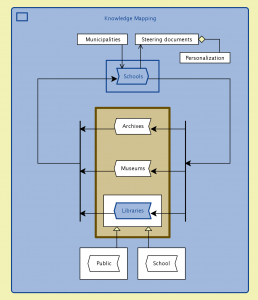
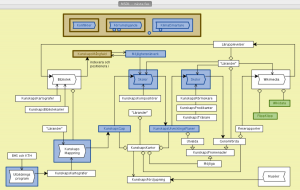
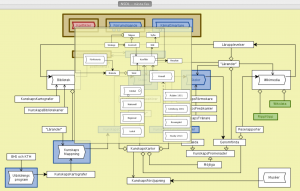
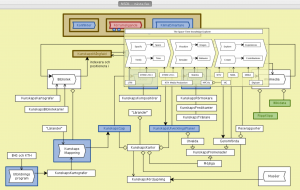
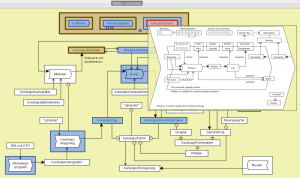
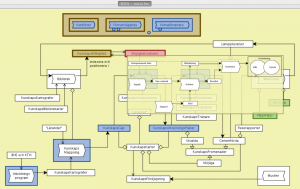
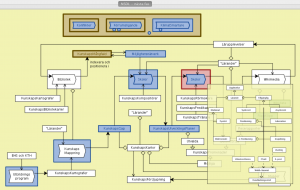
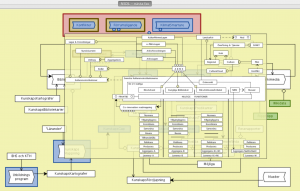
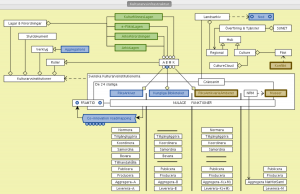
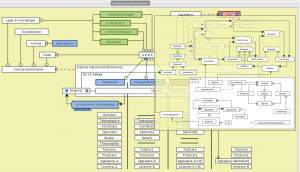
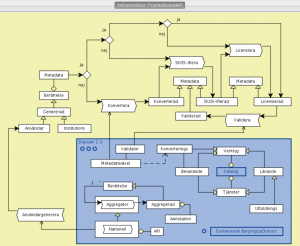
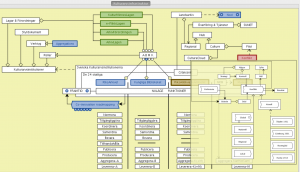
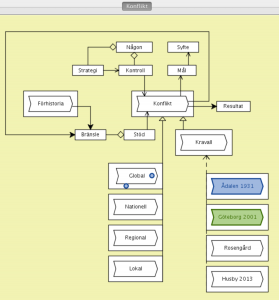
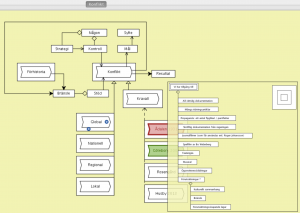
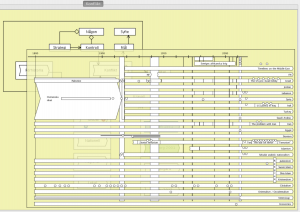
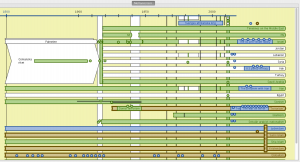
Thank you for the good writeup. It in fact was a amusement account it. Look advanced to far added agreeable from you! However, how could we communicate?